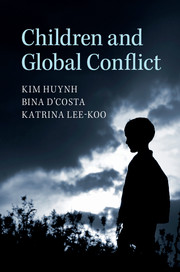Book contents
- Frontmatter
- Dedication
- Contents
- List of abbreviations
- Introduction: why children matter to global conflict
- 1 Children and armed conflict: mapping the terrain
- 2 Children and agency: caretakers, free-rangers and everyday life
- 3 Children and IR: creating spaces for children
- 4 The rights of the child: political history, practices and protection
- 5 Child soldiers: causes, solutions and cultures
- 6 Child forced migrants: bio-politics, autonomy and ambivalence
- 7 Children and peace building: propagating peace
- 8 Children and justice: past crimes, healing and the future
- 9 Who speaks for children? Advocacy, activism and resistance
- Conclusion
- Appendix
- Bibliography
- Index
8 - Children and justice: past crimes, healing and the future
Published online by Cambridge University Press: 05 May 2015
- Frontmatter
- Dedication
- Contents
- List of abbreviations
- Introduction: why children matter to global conflict
- 1 Children and armed conflict: mapping the terrain
- 2 Children and agency: caretakers, free-rangers and everyday life
- 3 Children and IR: creating spaces for children
- 4 The rights of the child: political history, practices and protection
- 5 Child soldiers: causes, solutions and cultures
- 6 Child forced migrants: bio-politics, autonomy and ambivalence
- 7 Children and peace building: propagating peace
- 8 Children and justice: past crimes, healing and the future
- 9 Who speaks for children? Advocacy, activism and resistance
- Conclusion
- Appendix
- Bibliography
- Index
Summary
Introduction
Narrated by Death, who is haunted by humans, Marcus Zusak's The Book Thief is a powerful story about Liesel Meminger, a nine-year-old German girl. Liesel is given up by her mother to live with Hans and Rosa Hubermann shortly before World War II. Hans then agrees to hide twenty-four-year-old Max Vandenburg, who befriends Liesel. After Max is taken to a concentration camp, Liesel falls into despair and starts to disdain the written word, seeing Hitler's words as the source of her suffering:
The words. Why did they have to exist? Without them, there wouldn't be any of this. Without words, the Führer was nothing. There would be no limping prisoners, no need for consolation or wordly tricks to make us feel better. What good were the words? She said it audibly now, to the orange-lit room. ‘What good are the words?’
Zusak represents children as having a remarkably creative ability to analyse a world that is at times too brutal even for adults to comprehend. Liesel realises that Mein Kampf and Hitler's propaganda are fuelling the war around her, and therefore constitute the ultimate cause of her grief. Liesel's struggles and the unbearable choices that the war forces upon her and her family echo questions about the justice and injustice of war.
Moving away from fiction, the real-life tale of thirteen-year-old Jewish girl Anne Frank has become an iconic account of the Holocaust, especially of children bearing witness to violence. The Frank family went into hiding in July 1942 in the top two floors and attic that formed part of their Amsterdam family business. Assisted by Dutch friends they managed to remain undetected until August 1944, when they were betrayed and sent to the concentration camps. The father, Otto, survived the ordeal and after his return was given Anne's diary, kept safe by their friends. Anne died in Bergen-Belsen in 1945, just six months before the end of the war.
- Type
- Chapter
- Information
- Children and Global Conflict , pp. 212 - 248Publisher: Cambridge University PressPrint publication year: 2015

